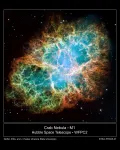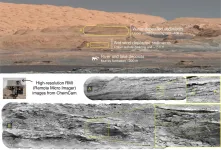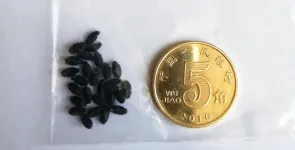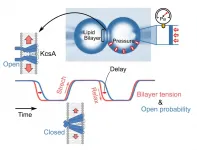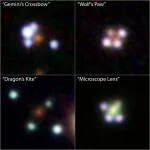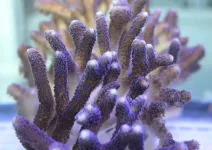(Press-News.org) A global science collaboration using data from NASA's Neutron star Interior Composition Explorer (NICER) telescope on the International Space Station has discovered X-ray surges accompanying radio bursts from the pulsar in the Crab Nebula. The finding shows that these bursts, called giant radio pulses, release far more energy than previously suspected.
A pulsar is a type of rapidly spinning neutron star, the crushed, city-sized core of a star that exploded as a supernova. A young, isolated neutron star can spin dozens of times each second, and its whirling magnetic field powers beams of radio waves, visible light, X-rays, and gamma rays. If these beams sweep past Earth, astronomers observe clock-like pulses of emission and classify the object as a pulsar.
"Out of more than 2,800 pulsars cataloged, the Crab pulsar is one of only a few that emit giant radio pulses, which occur sporadically and can be hundreds to thousands of times brighter than the regular pulses," said lead scientist Teruaki Enoto at the RIKEN Cluster for Pioneering Research in Wako, Saitama prefecture, Japan. "After decades of observations, only the Crab has been shown to enhance its giant radio pulses with emission from other parts of the spectrum."
The new study, which will appear in the April 9 edition of Science and is now available online, analyzed the largest amount of simultaneous X-ray and radio data ever collected from a pulsar. It extends the observed energy range associated with this enhancement phenomenon by thousands of times.
Located about 6,500 light-years away in the constellation Taurus, the Crab Nebula and its pulsar formed in a supernova whose light reached Earth in July 1054. The neutron star spins 30 times each second, and at X-ray and radio wavelengths it is among the brightest pulsars in the sky.
Between August 2017 and August 2019, Enoto and his colleagues used NICER to repeatedly observe the Crab pulsar in X-rays with energies up to 10,000 electron volts, or thousands of times that of visible light. While NICER was watching, the team also studied the object using at least one of two ground-based radio telescopes in Japan - the 34-meter dish at the Kashima Space Technology Center and the 64-meter dish at the Japan Aerospace Exploration Agency's Usuda Deep Space Center, both operating at a frequency of 2 gigahertz.
he combined dataset effectively gave the researchers nearly a day and a half of simultaneous X-ray and radio coverage. All told, they captured activity across 3.7 million pulsar rotations and netted some 26,000 giant radio pulses.
Giant pulses erupt quickly, spiking in millionths of a second, and occur unpredictably. However, when they occur, they coincide with the regular clockwork pulsations.
NICER records the arrival time of every X-ray it detects to within 100 nanoseconds, but the telescope's timing precision isn't its only advantage for this study.
"NICER's capacity for observing bright X-ray sources is nearly four times greater than the combined brightness of both the pulsar and its nebula," said Zaven Arzoumanian, the project's science lead at NASA's Goddard Space Flight Center in Greenbelt, Maryland. "So these observations were largely unaffected by pileup - where a detector counts two or more X-rays as a single event - and other issues that have complicated earlier analyses."
Enoto's team combined all of the X-ray data that coincided with giant radio pulses, revealing an X-ray boost of about 4% that occurred in synch with them. It's remarkably similar to the 3% rise in visible light also associated with the phenomenon, discovered in 2003. Compared to the brightness difference between the Crab's regular and giant pulses, these changes are remarkably small and provide a challenge for theoretical models to explain.
The enhancements suggest that giant pulses are a manifestation of underlying processes that produce emission spanning the electromagnetic spectrum, from radio to X-rays. And because X-rays pack millions of times the punch of radio waves, even a modest increase represents a large energy contribution. The researchers conclude that the total emitted energy associated with a giant pulse is dozens to hundreds of times higher than previously estimated from the radio and optical data alone.
"We still don't understand how or where pulsars produce their complex and wide-ranging emission, and it's gratifying to have contributed another piece to the multiwavelength puzzle of these fascinating objects," Enoto said.
INFORMATION:
NICER is an Astrophysics Mission of Opportunity within NASA's Explorers program, which provides frequent flight opportunities for world-class scientific investigations from space utilizing innovative, streamlined and efficient management approaches within the heliophysics and astrophysics science areas. NASA's Space Technology Mission Directorate supports the SEXTANT component of the mission, demonstrating pulsar-based spacecraft navigation.
Banner: The Crab Nebula, the six-light-year-wide expanding cloud of debris from a supernova explosion, hosts a neutron star spinning 30 times a second that is among the brightest pulsars in the sky at X-ray and radio wavelengths. This composite of Hubble Space Telescope images reveals different gases expelled in the explosion: blue reveals neutral oxygen, green shows singly ionized sulfur, and red indicates doubly ionized oxygen. Credit: NASA, ESA, J. Hester and A. Loll (Arizona State University)
By Francis Reddy
NASA's Goddard Space Flight Center, Greenbelt, Md.
Media contact:
Claire Andreoli
NASA's Goddard Space Flight Center, Greenbelt, Md.
(301) 286-1940
SALT LAKE CITY - A letter published today by Huntsman Cancer Institute (HCI) at the University of Utah (U of U) in the New England Journal of Medicine reports that melanoma mortality among Utahns outpaced that of the rest of the United States during the period from 1975 to 2013. Melanoma death rates have been decreasing in recent years both in Utah and the United States, a trend likely attributable to new, more effective treatments, like immunotherapy. However, melanoma remains the deadliest type of skin cancer, and the incidence of melanoma diagnoses in Utahns is higher than in any other ...
LOS ALAMOS, N.M., April 8, 2021-While attention has been focused on the Perseverance rover that landed on Mars last month, its predecessor Curiosity continues to explore the base of Mount Sharp on the red planet and is still making discoveries. Research published today in the journal Geology shows that Mars had drier and wetter eras before drying up completely about 3 billion years ago.
"A primary goal of the Curiosity mission was to study the transition between the habitable environment of the past, to the dry and cold climate that Mars has now. These rock layers recorded that change in great detail," said Roger Wiens, a coauthor on the paper and scientist at Los Alamos National Laboratory, ...
PHILADELPHIA (April 8, 2021) - Many factors, including need, affect healthcare use. Strategies geared to enhancing the provision and access to healthcare must consider the various mechanisms that contribute to healthcare need and use. Until now, the mechanism of violence and its impact on both health and healthcare use has not been investigated.
A new study from the University of Pennsylvania School of Nursing (Penn Nursing) is one of the first to examine the association between violence exposure and healthcare service utilization in Mexico. Results are published in the International Journal of Health Equity.
Widespread violence in Mexico can impact health through various channels. The study ...
When it comes to choosing a partner, humans tend to be attracted by characteristics like personality and common interests. In contrast, insects tend to be a bit shallow, as they choose a mate based on appearance, and in some cases, smells. One example is the leaf beetle, which produces chemical pheromones that are on their cuticles, or the exterior surface of the beetle. They use these 'scents' to assess beetle sex and mating status (whether beetles are sexually mature or not).
Kari Segraves, professor of biology in the College of Arts and Sciences, is interested in researching the chemical and visual signals that contribute to mate selection by these beetles. This work is part of a larger project focused on understanding how new species are formed. By definition, species are related ...
Ion channels play an indispensable role in cellular physiology, and understanding the physical features that affect ion channel functions is a matter of considerable interest to biologists. Given that mechanosensitivity is an intrinsic feature of cells, the complex set of mechanical stresses acting on a cell at any time represents an important consideration in the field of cellular physiology. In fact, stretching forces created by mechanical stress are sometimes necessary to activate ion channels. As Professor Masayuki Iwamoto and Professor Shigetoshi Oiki of the University of Fukui ...
BIRMINGHAM, Ala. - Six years ago, Michael Niederweis, Ph.D., described the first toxin ever found for the deadly pathogen Mycobacterium tuberculosis. This toxin, tuberculosis necrotizing toxin, or TNT, became the founding member of a novel class of previously unrecognized toxins present in more than 600 bacterial and fungal species, as determined by protein sequence similarity. The toxin is released as M. tuberculosis bacteria survive and grow inside their human macrophage host, killing the macrophage and allowing the escape and spread of the bacteria.
For 132 years, ...
With the help of machine-learning techniques, a team of astronomers has discovered a dozen quasars that have been warped by a naturally occurring cosmic "lens" and split into four similar images. Quasars are extremely luminous cores of distant galaxies that are powered by supermassive black holes.
Over the past four decades, astronomers had found about 50 of these "quadruply imaged quasars," or quads for short, which occur when the gravity of a massive galaxy that happens to sit in front of a quasar splits its single image into four. The latest study, which spanned only a year and a half, increases the number of known quads by about 25 percent and demonstrates the power of machine learning to assist ...
Past surveys have shown that more than 80% of dog owners report observing jealous behaviors from their dogs--vocalizations, agitated behavior, pulling on a leash--when they give attention to other dogs. New research published in the journal Psychological Science supports these observations and finds that dogs also exhibit jealous behaviors when they merely imagine that their owner is interacting with a potential rival, in this case, a highly realistic artificial dog.
"Research has supported what many dog owners firmly believe--dogs exhibit jealous behavior when their human companion interacts with a potential rival," said Amalia Bastos with ...
Charles Darwin, the British naturalist who championed the theory of evolution, noted that corals form far-reaching structures, largely made of limestone, that surround tropical islands. He didn't know how they performed this feat.
Now, Rutgers scientists have shown that coral structures consist of a biomineral containing a highly organized organic mix of proteins that resembles what is in our bones. Their study, published in the END ...
A new study shows that several disagreements between Ethiopia, Sudan and Egypt around Africa's largest hydropower plant, the new Grand Ethiopian Renaissance Dam (GERD), could be alleviated by massively expanding solar and wind power across the region. Adapting GERD operation to support grid integration of solar and wind power would provide tangible energy and water benefits to all involved countries, creating regional win-win situations. "Our results call for integrated hydro-solar-wind planning to be taken up in the GERD negotiations," says Sebastian Sterl, energy ...
